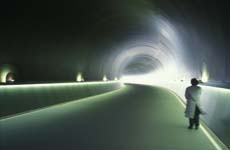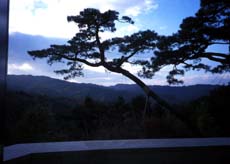index
The Miho Museum
click on images for full-size:




The tunnel path to the Miho Museum, an hour from Kyoto

The bridge over the valley towards the Miho Museum

View from a balcony at the Miho Museum. (Photos could not be taken inside the building.)
We visited the Miho Museum. Mistrusting I. M. Pei's tendency for the grand gesture, I worried about this place. The gestures were there but they worked: I found myself continually surprised as we entered. Not always pleased, but surprised. Effects were called for and delivered with the dramatic tunnel/bridge entry, and in the spacious building half buried into the mountain top. Pei had a perfect client: imaginative, open, with limitless resources. The result: architectural gestures carried through with bravura on the large and the small scale, Subtle, it isn't. But impressive, it is what they wanted. Panache, done with care. The result is a place with a single-minded self-presentation. You are told what attitudes to have, what bodily postures to adopt. The architectural promenade of the tunnel and bridge entrance is explained before you get to it, by labels telling you to recall the peach valley folk tale. The art is well displayed, as you would expect, and always in the expected ways. Isolation and downlighting. The labels are appreciative rather than analytic. But, again, that was what they wanted. The Miho collection is small enough and the building large enough that pieces are given room to breathe. It is wonderful to have a gallery containing a single object (such as the Gandharan Buddha), or a small group of objects that speak to one another (such as a small gallery devoted to a few ceramics by Kenzan). Someday virtual reality may make such dramatic presentation possible for any object; you will be able to assemble a personal gallery containing a few chosen artworks that speak together, while other people combine works in other ways. Museum direction may become the self-publication of views and clusters.